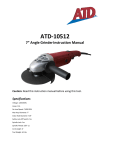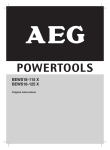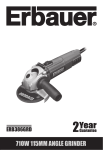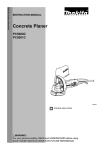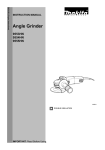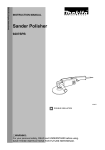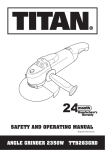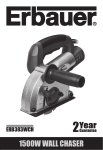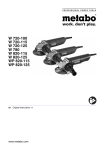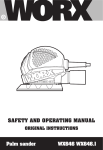Download ATD Tools ATD?10512 Specifications
Transcript
ATD‐10512 7” Angle Grinder Instruction Manual Caution: Read this instruction manual before using this tool. Specifications Voltage: 120V/60Hz Amps: 11A No Load Speed: 7,800 RPM Max Accy Diameter: 7” Arbor Hole Diameter: 7/8” Safety Lock‐Off Switch: Yes Spindle Lock: Yes Spindle Thread: 5/8”‐11 Cord Length: 6.5’ Tool Weight: 7.5 lbs WARNING: This product contains chemicals including lead, known to the State of California to cause cancer, birth defects, or other reproductive harm. Wash hands after handling. WARNING: Some dust created by power sanding, sawing, grinding, drilling and other construction activities contains chemicals known to the State of California to cause cancer, birth defects, or other reproductive harm. Some examples of these chemicals are: • Lead from lead based paint, • Crystalline silica from bricks, cement, and other masonry products, and • Arsenic and chromium from chemically treated lumber. Your risk from exposure varies, depending on how often you do this work. To reduce your exposure to these chemicals: work in a well‐ventilated area, and with approved safety equipment, such as dust masks that are specifically designed to filter out microscopic particles. General Power Tool Safety Warnings WARNING Read all safety warnings and instructions. Failure to follow the warnings and instructions may result in electric shock, fire and/or serious injury. Save all warnings and instructions for future reference. The term "power tool" in the warnings refers to your mains‐operated (corded) power tool or battery‐operated (cordless) power tool. 1) Work area safety a) Keep work area clean and well lit. Cluttered or dark areas invite accidents. b) Do not operate power tools in explosive atmospheres, such as in the presence of flammable liquids, gases or dust. Power tools create sparks which may ignite the dust or fumes. c) Keep children and bystanders away while operating a power tool. Distractions can cause you to lose control. 2) Electrical safety a) Power tool plugs must match the outlet. Never modify the plug in any way. Do not use any adapter plugs with earthed (grounded) power tools. Unmodified plugs and matching outlets will reduce risk of electric shock. b) Avoid body contact with earthed or grounded surfaces such as pipes, radiators, ranges and refrigerators. There is an increased risk of electric shock if your body is earthed or grounded. c) Do not expose power tools to rain or wet conditions. Water entering a power tool will increase the risk of electric shock. d) Do not abuse the cord. Never use the cord for carrying, pulling or unplugging the power tool. Keep cord away from heat, oil, sharp edges or moving parts. Damaged or entangled cords increase the risk of electric shock. e) When operating a power tool outdoors, use an extension cord suitable for outdoor use. Use of a cord suitable for outdoor use reduces the risk of electric shock. f) If operating a power tool in a damp location is unavoidable, use a residual current device (RCD) protected supply. Use of an RCD reduces the risk of electric shock. 3) Personal safety a) Stay alert, watch what you are doing and use common sense when operating a power tool. Do not use a power tool while you are tired or under the influence of drugs, alcohol or medication. A moment of inattention while operating power tools may result in serious personal injury. b) Use personal protective equipment. Always wear eye protection. Protective equipment such as dust mask, non‐skid safety shoes, hard hat, or hearing protection used for appropriate conditions will reduce personal injuries. c) Prevent unintentional starting. Ensure the switch is in the off‐position before connecting to power source and/or battery pack, picking up or carrying the tool. Carrying power tools with your finger on the switch or energizing power tools that have the switch on invites accidents. d) Remove any adjusting key or wrench before turning the power tool on. A wrench or a key left attached to a rotating part of the power tool may result in personal injury. e) Do not overreach. Keep proper footing and balance at all times. This enables better control of the power tool in unexpected situations. f) Dress properly. Do not wear loose clothing or jewelry. Keep your hair, clothing and gloves away from moving parts. Loose clothes, jewelry or long hair can be caught in moving parts. g) If devices are provided for the connection of dust extraction and collection facilities, ensure these are connected and properly used. Use of dust collection can reduce dust‐related hazards. 4) Power tool use and care a) Do not force the power tool. Use the correct power tool for your application. The correct power tool will do the job better and safer at the rate for which it was designed. b) Do not use the power tool if the switch does not turn it on and off. Any power tool that cannot be controlled with the switch is dangerous and must be repaired. c) Disconnect the plug from the power source and/or the battery pack from the power tool before making any adjustments, changing accessories, or storing power tools. Such preventive safety measures reduce the risk of starting the power tool accidentally. d) Store idle power tools out of the reach of children and do not allow persons unfamiliar with the power tool or these instructions to operate the power tool. Power tools are dangerous in the hands of untrained users. e) Maintain power tools. Check for misalignment or binding of moving parts, breakage of parts and any other condition that may affect the power tool’s operation. If damaged, have the power tool repaired before use. Many accidents are caused by poorly maintained power tools. f) Keep cutting tools sharp and clean. Properly maintained cutting tools with sharp cutting edges are less likely to bind and are easier to control. g) Use the power tool, accessories and tool bits etc. in accordance with these instructions, taking into account the working conditions and the work to be performed. Use of the power tool for operations different from those intended could result in a hazardous situation. 5) Service a) Have your power tool serviced by a qualified repair person using only identical replacement parts. This will ensure that the safety of the power tool is maintained. Safety instructions for all operations Safety Warnings for Grinding Operations: a) This power tool is intended to function as a grinder. Read all safety warnings, instructions, illustrations and specifications provided with this power tool. Failure to follow all instructions listed below may result in electric shock, fire and/or serious injury. b) Operations such as sanding, wire brushing, polishing or cutting‐off are not recommended to be performed with this power tool. Operations for which the power tool was not designed may create a hazard and cause personal injury. c) Do not use accessories which are not specifically designed and recommended by the tool manufacturer. Just because the accessory can be attached to your power tool, it does not assure safe operation. d) The rated speed of the accessory must be at least equal to the maximum speed marked on the power tool. Accessories running faster than their RATED SPEED can break and fly apart. e) The outside diameter and the thickness of your accessory must be within the capacity rating of your power tool. Incorrectly sized accessories cannot be adequately guarded or controlled. f) The arbor size of wheels, flanges, backing pads or any other accessory must properly fit the spindle of the power tool. Accessories with arbor holes that do not match the mounting hardware of the power tool will run out of balance, vibrate excessively and may cause loss of control. g) Do not use a damaged accessory. Before each use inspect the accessory such as abrasive wheels for chips and cracks, backing pad for cracks, tear or excess wear, wire brush for loose or cracked wires. If power tool or accessory is dropped, inspect for damage or install an undamaged accessory. After inspecting and installing an accessory, position yourself and bystanders away from the plane of the rotating accessory and run the power tool at maximum no‐load speed for one minute. Damaged accessories will normally break apart during this test time. h) Wear personal protective equipment. Depending on application, use face shield, safety goggles or safety glasses. As appropriate, wear dust mask, hearing protectors, gloves and workshop apron capable of stopping small abrasive or work piece fragments. The eye protection must be capable of stopping flying debris generated by various operations. The eye protection must be capable of stopping flying debris generated by various operations. The dust mask or respirator must be capable of filtrating particles generated by your operation. Prolonged exposure to high intensity noise may cause hearing loss. i) Keep bystanders a safe distance away from work area. Anyone entering the work area must wear personal protective equipment. Fragments of work piece or of a broken accessory may fly away and cause injury beyond immediate area of operation. j) Hold power tool by insulated gripping surfaces only, when performing an operation where the cutting accessory may contact hidden wiring or its own cord. Cutting accessory contacting a “live” wire may make exposed metal parts of the power tool “live” and shock the operator. k) Position the cord clear of the spinning accessory. If you lose control, the cord may be cut or snagged and your hand or arm may be pulled into the spinning accessory. l) Never lay the power tool down until the accessory has come to a complete stop. The spinning accessory may grab the surface and pull the power tool out of your control. m) Do not run the power tool while carrying it at your side. Accidental contact with the spinning accessory could snag your clothing, pulling the accessory into your body. n) Regularly clean the power tool’s air vents. The motor’s fan will draw the dust inside the housing and excessive accumulation of powdered metal may cause electrical hazards. o) Do not operate the power tool near flammable materials. Sparks could ignite these materials. p) Do not use accessories that require liquid coolants. Using water or other liquid coolants may result in electrocution or shock. Kickback and Related Warnings Kickback is a sudden reaction to a pinched or snagged rotating wheel, backing pad, brush or any other accessory. Pinching or snagging causes rapid stalling of the rotating accessory which in turn causes the uncontrolled power tool to be forced in the direction opposite of the accessory’s rotation at the point of the binding. For example, if an abrasive wheel is snagged or pinched by the work piece, the edge of the wheel that is entering into the pinch point can dig into the surface of the material causing the wheel to climb out or kick out. The wheel may either jump toward or away from the operator, depending on direction of the wheel’s movement at the point of pinching. Abrasive wheels may also break under these conditions. Kickback is the result of power tool misuse and/or incorrect operating procedures or conditions and can be avoided by taking proper precautions as given below. a) Maintain a firm grip on the power tool and position your body and arm to allow you to resist kickback forces. Always use auxiliary handle, if provided, for maximum control over kickback or torque reaction during start‐up. The operator can control torque reactions or kickback forces, if proper precautions are taken. b) Never place your hand near the rotating accessory. Accessory may kickback over your hand. c) Do not position your body in the area where power tool will move if kickback occurs. Kickback will propel the tool in direction opposite to the wheel’s movement at the point of snagging. d) Use special care when working corners, sharp edges etc. Avoid bouncing and snagging the accessory. Corners, sharp edges or bouncing have a tendency to snag the rotating accessory and cause loss of control or kickback. e) Do not attach a saw chain woodcarving blade or toothed saw blade. Such blades create frequent kickback and loss of control. Safety Warnings Specific for Grinding Operations: a) Use only wheel types that are recommended for your power tool and the specific guard designed for the selected wheel. Wheels for which the power tool was not designed cannot be adequately guarded and are unsafe. b) The guard must be securely attached to the power tool and positioned for maximum safety, so the least amount of wheel is exposed towards the operator. The guard helps to protect operator from broken wheel fragments and accidental contact with wheel. c) Wheels must be used only for recommended applications. For example: do not grind with the side of cut‐off wheel. Abrasive cut‐off wheels are intended for peripheral grinding, side forces applied to these wheels may cause them to shatter. d) Always use undamaged wheel flanges that are of correct size and shape for your selected wheel. Proper wheel flanges support the wheel thus reducing the possibility of wheel breakage. Flanges for cut‐off wheels may be different from grinding wheel flanges. e) Do not use worn down wheels from larger power tools. Wheel intended for larger power tool is not suitable for the higher speed of a smaller tool and may burst. ADDITIONAL SAFETY REGULATIONS Always use proper guard with grinding wheel. A guard protects operator from broken wheel fragments. Accessories must be rated for at least the speed recommended on the tool warning label. Wheels and other accessories running over rated speed can fly apart and cause injury. Hold tool by insulated gripping surfaces when performing an operation where the cutting tools may contact hidden wiring or its own cord. Contact with a “live” wire will make exposed metal parts of the tool “live” and shock the operator. When the machine is in operation, keep hands away from the grinding area. The disc will not stop immediately the machine is turned off. Exercise caution. Do not place the tool down after use until the grinding wheels have come to complete stop. Do not start the tool when the grinding wheels are touching the work area. Always ensure the safety guard is attached correctly and do not operate the angle grinder without the guard attached. Only use grinding wheels that are approved for a maximum speed of marked or greater. Only use grinding wheels with the correct bore size for the spindle of the grinder. Keep the power cord well away from the cutting area during use. Always position the cord so that it will not be caught in the work piece when the grinder is in use. Always wear earmuffs, safety glasses and face mask while in operation. Before connecting the tool to the power supply follow the safety instructions to install the grinding wheels. Do not lock it too tight, otherwise cracks may occur. Always use both hands when operation the tool Use the standard parts. Do not use a coolant or water and do not use as a fixed grinder. 1. Introduction This tool is intended for grinding and deburring metal materials without the use of water. Do not apply pressure on the tool; let the speed of the cutting disc do the work Read and save this instruction manual. Tool specifications: Model ATD‐10512 Voltage (V) Frequency (Hz) Rated Current (A) No‐load speed (Min‐1) Disc dia. (mm) Spindle Thread 60 11 7800 7” 5/8” 120 1. Auxiliary handle 2. Spindle lock button 3. On/off switch 4. Square nut 5. Hex .screw 6. Grinding guard 7. Inner flange 8. Grinding disc 9. Outer flange 10. Spanner 2. Assembly Warning: Switch off the grinder and disconnect it from the power point. 1) The auxiliary handle (1) can be screwed to the left or the right of Gear Box. Select the position which gives the most comfortable and safe use. 2) Fitting the grinding guard: (See figure 1 and 2) A: Position the lug on the inside of the central guard ring in the vertical in the spindle cover then Place the Wheel guard cover and right the hole; B: The guard shall be position in the neutral position. C: Tighten the pan head screw in a clockwise direction using the screwdriver until the screw is tighten up and the pan cannot be moved anymore. Figure 1 Figure2 3) Fitting the grinding disc: (Figure 3 and Figure 4) A. Place the inner flange (7) over the spindle making sure the fit is tight B. Place the grinding disc(8) on the top of the inner flange ensuring the bore fits into the step of the flange C. Mount the concave recess side of the outer flange (9) over the spindle D. Press the spindle locking button (2) firm and ensure there is no movement in the spindle. While the spindle lock is depressed, tighten the outer flange in a clockwise direction using the spanner (10).(See figure 4) Figure 3 Figure 4 Allow the angle grinder to run in idle for at least a minute with the grinding, vibration disc should be immediately replaced. 3. Operation Switch On/off the tool 1) When starting hold the tool firmly with both hands i.e. One hand on the motor housing and the other on the side auxiliary handle (1). 2) Start the tool by pressing trigger inwards, then the tool is energized and starts to operate. (See figure 5) 3) The tool will stop as soon as releasing the trigger of switch. Figure 5 Lock the tool in the “on” position 1) When starting hold the tool firmly with both hands i.e. one hand on the motor housing and the other on the side auxiliary handle (1). 2) Start the tool by pressing trigger inwards, and then press the lock button at side to lock the tool at “on” condition. In this condition, the tool will operate continuously without pressing the trigger all the time (See figure 5) 3) Stop the tool by actuating the switch trigger again. 4. Operating instructions Note: This angle grinder can be used for grinding steel, stone or ceramic work pieces such as pipe, box section, rectangular, angle iron steel bar, household bricks and tiles. Do not attempt to grind wood or a soft metal such as lead. The material will quickly “fill” the disc and render it useless. Before starting the grinder first ensure that the disc, disc guard and tool are in good condition. Position the guard so that it will deflect hot sparks away from the operator. 1) Do not cover vents when the tool is in use. This may cause damage to the motor and reduce the efficiency of the tool. 2) Guide back and forth over the work piece in a steady motion. Grinding The best results are achieved with an angle of 200 to 300 for grinding. Move the machine back and forth with light pressure. In this manner, the work piece does not become too hot, no discoloration occurs and no ridges are produced. Under no circumstances should a cutting disc be used for roughing work. 5. Maintance and inspection 1) The armature and stator (motor) is the heart of the power tool. Exercise due care to ensure they do not become damaged or affected by oil or water. 2) Inspect the carbon brushes regularly and replace when they are worn up about one third. 3) Regularly inspect all mountings and screws and ensure they are properly tightened. Showed any of the screws be loose, tighten them immediately. Failure to do so may result in serious damage. 4) The supply cord of the tool and any extension cord used should be checked frequently for damage. If damaged, have the cord set replaced by an authorized service facility. Replace the extension cord if necessary. 5) The grease in the gearbox will require replacement after extensive use of the tool. Please refer to an authorized service agent to provide this service. 6) Consult an authorized service agent in the event of failure. 7) Clean and dust the tool after each use. 6. Accessories CAUTION: These accessories or attachments are recommended for use with your tool specified in this manual. The use of any other accessories or attachments might present a risk of injury to persons. Only use accessory or attachment for its stated purpose. Auxiliary handle 1pc Spanner 1pc Inner Hex. Spanner 1pc Grinding Wheel 1pc









